Peperomia Plant Care Guide
HOW TO GROW AND CARE FOR PEPEROMIA
By Julianne Blackaby | 25/09/2023
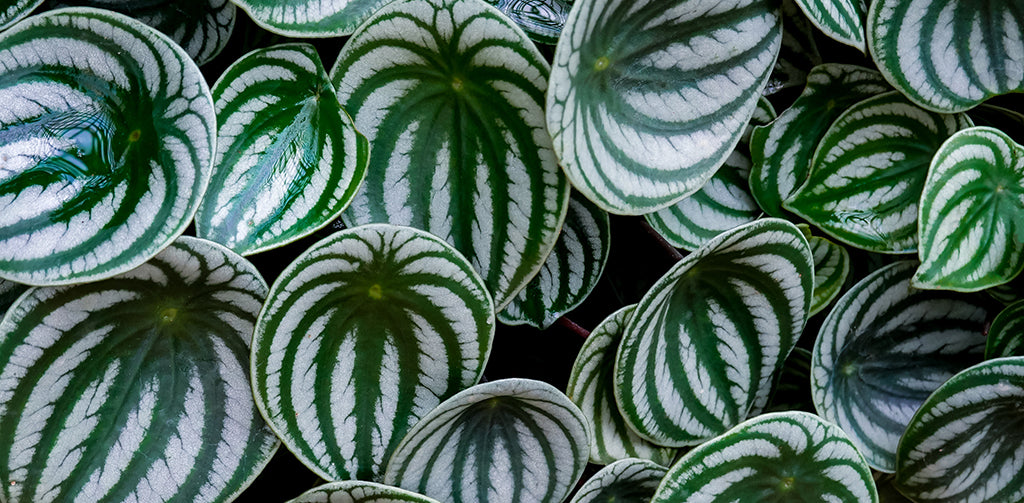 📷 Watermelon Peperomia, Chalet Boutique
📷 Watermelon Peperomia, Chalet Boutique
|
Common Varieties |
Peperomia obtusifolia (Baby Rubber Plant), Peperomia caperata (Ripple Peperomia), Peperomia prostrata (String of Turtles), Peperomia argyreia (Watermelon Peperomia), Peperomia incana (Felted Peperomia), Peperomia puteolata (Parallel Peperomia), Peperomia rotundifolia (Trailing Jade), Peperomia clusiifolia (Red Edge Peperomia), Peperomia ferreyrae (Happy Bean), and Peperomia tetragona (Parallel Peperomia). |
|
Botanical Name |
Peperomia spp. |
|
Family |
Piperaceae |
|
Plant Type |
Perennial herbaceous plant |
|
Mature Size |
Varies by species, typically ranging from 15 to 60 centimetres in height. |
|
Light |
Bright, indirect light, but adaptable to different light conditions. |
|
Soil Type |
Well-draining aroid mix |
|
Native Areas |
Native to tropical and subtropical regions of Central and South America. |
|
Toxicity |
Peperomia plants are generally considered safe but may be mildly toxic if ingested. It's recommended to keep them out of reach of pets and children. Skin contact with the sap is usually not problematic but may cause minor irritation in some individuals. |
Our guide will provide all the information you need to keep your Peperomia healthy and content, including tips on light and temperature needs, watering and fertilising, and how to propagate your plant. Let's embark on the journey of Peperomia plant care together!
WELCOME TO YOUR COMPLETE GUIDE TO CARING FOR PEPEROMIAS
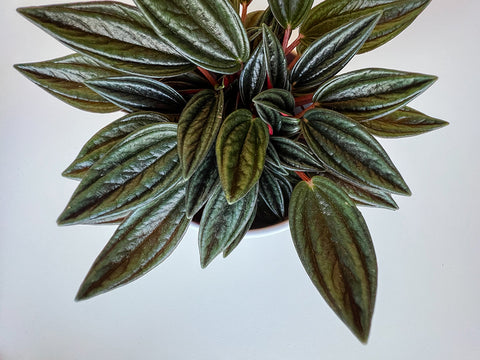
HOW MUCH LIGHT DOES A PEPEROMIA NEED?
Peperomia plants are straightforward to care for and require very little light to thrive. The ideal light for a peperomia plant is bright, indirect light, such as a few hours of morning sun or sunlight coming through a window. They don't do well in direct sunlight and should be kept away from hot, direct sunlight. Too much light can cause the leaves to become scorched or burned, so keeping them well-lit with indirect light is essential. Peperomia plants tolerate lower light conditions and do fine in shady or indirect sunlight. If the plant is not getting enough light, it will become leggy, and the leaves will pale.
HOW OFTEN SHOULD I WATER A PEPEROMIA?
The frequency of watering a Peperomia plant will depend on the growing conditions and the potting mix used in the container. You should water the plant when the top 3-5cm of soil is dry. Keeping the soil evenly moist but not soggy during the growing season is essential. If the potting mix is allowed to dry out completely between each watering, the plant will suffer from stress and may eventually die. It's also important to check the potting mix for signs of overwatering, like soggy soil or root rot. If the soil is too wet, reduce the watering frequency or repot the plant in a well-drained potting mix.
WHAT IS THE BEST POTTING MEDIUM FOR PEPEROMIA?
The best potting medium for Peperomia is a well-draining, light, and airy mix. Combining equal parts peat moss, perlite, and vermiculite is ideal. Peat moss helps retain moisture, perlite and vermiculite help promote drainage and aeration, and all three components provide a balanced environment for Peperomia to thrive.
 📷 Peperomia marble, Chalet Boutique
📷 Peperomia marble, Chalet Boutique
WHAT IS THE BEST TEMPERATURE FOR PEPEROMIA?
The best temperature for Peperomia is between 18-24°C during the day and between 10-15°C at night. It should not drop below 10°C as this can cause the plant to shock. In addition, the plant should be kept away from cold drafts and direct sunlight.
WHAT IS THE BEST HUMIDITY FOR PEPEROMIA?
The best humidity for Peperomia plants is between 60-80%. This means the air should not be too wet or dry but comfortably in between. You can also place a humidity tray or pebble tray near the plant to help increase humidity levels. Keeping plants in a group helps provide an excellent microclimate. With the correct humidity levels and proper care, your Peperomia will stay healthy and vibrant.
WHAT IS THE BEST FERTILISER FOR PEPEROMIA?
We use Growth Technology, Foliage Focus for all our Tradescantias, here's why:
- Each GT Focus product is complete. Unlike the overwhelming majority of fertilisers, all Focus products contain each of the 12 essential minerals – including Calcium – blended into an easily absorbed liquid concentrate.

- pH buffered to ensure all 12 essential minerals are available to the plant.
- Formulated and balanced to suit the requirements of specific plant types.
- Manufactured using only the highest-grade raw materials and chelated trace elements to ensure effortless absorption by the plant.
- Guaranteed not to contain potentially harmful and ineffective chlorides, urea, sodium and ammonium.
- Easy to use with simple instructions.
- Makes up to 200 litres of working solution
WHAT ARE COMMON PEPEROMIA PESTS AND HOW YOU TREAT THEM?
Ficus can be susceptible to various pests, including aphids, mealybugs, spider mites, and scale insects. The use of beneficial insects such as ladybugs, lacewings, and parasitic wasps can be effective biological control against these pests.
Aphids are small, soft-bodied insects that feed on plant juices. They can be identified by their pear-shaped bodies, usually black, green, yellow, or brown. Aphids can weaken the plant by sucking out its sap, leading to yellowing and/or wilting leaves. Treatment for aphids includes spraying the plant with a strong water stream or using an insecticidal soap or neem oil solution.
Mealybugs are small, white, fuzzy insects that feed on plant sap. They are usually found in clusters on the underside of the leaves. Mealybugs can be treated with insecticidal soap, neem oil, or a cotton swab dipped in rubbing alcohol to wipe them off.
Scale insects are tiny, flat, oval-shaped pests that feed on plant sap. They can also be identified by the white, waxy coating they produce. Treatment for scale insects includes wiping them off with a cotton swab dipped in rubbing alcohol or spraying the plant with neem oil.
Spider mites are tiny, eight-legged arachnids that feed on plant sap. They cause yellowing and stippling of the leaves and webbing on the foliage. Treatment for spider mites includes spraying the plant with Kill-a-mite or Stealth. By monitoring these common pests and treating them promptly, you can ensure your plant stays healthy and thrives.
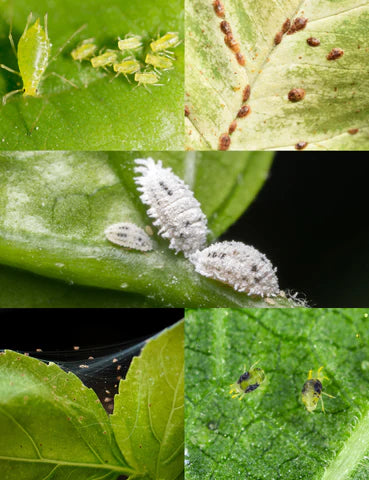
HOW TO PRUNE A PEPEROMIA
Pruning a peperomia is important in keeping your plant healthy and attractive. To prune a peperomia, start by assessing the shape and size of the plant. If you notice any dead, brown, or damaged leaves, remove them with a pair of sharp, clean pruning shears. Then, look for any long, straggly stems growing out of the centre of the plant or taking up too much space. You can prune these back to the desired length, being careful not to cut off any healthy leaves. Finally, look for any stems growing in an odd direction, and prune them back to the desired shape. Always use clean, sharp pruning shears and do not damage healthy leaves. With regular pruning, your peperomia will stay healthy and attractive and continue growing well.
HOW TO PROPAGATE A PEPEROMIA
Propagating a Peperomia is a great way to increase your collection of this beautiful, low-maintenance houseplant. start by cutting a stem with at least two leaf nodes to propergate your Peperomia. Remove the leaves from the bottom node, and dip the end of the cutting into rooting hormone. Then, place it in a pot filled with a well-draining potting mix. You can also water propagate by placing the cutting in a glass container and changing the water every few days until you see roots growing. Once you see roots, you can transplant the cutting into a new pot. Ensure to provide your new plant with bright, indirect light and keep the soil moist but not soggy. Your Peperomia will soon grow into a healthy and beautiful addition to your collection with proper care.
WHEN DO YOU NEED TO REPOT A PEPEROMIA?
When you need to repot a Peperomia, it is usually recommended to do so every two to three years. This is because the soil in a pot can deplete nutrients over time. Signs that your Peperomia needs to be repotted include a slower rate of growth, the soil becoming dry and crumbly, and the plant becoming root-bound. When you repot a Peperomia, you should use a pot at least two inches wider than the previous one, and it should also have a sound drainage system. Before repotting, it's essential to loosen the soil around the plant's roots by gently shaking it and using your fingers to separate them. After repotting, you should also water your Peperomia more frequently than usual for a few weeks to keep the soil moist and the plant healthy.
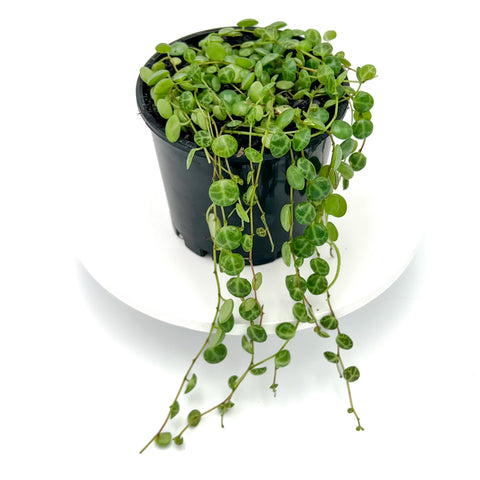
WHAT SORT OF POT DOES PEPEROMIA ENJOY?
Peperomia plants enjoy high-quality, well-draining potting soil, with organic matter consisting of perlite, quality potting mix, and small pieces of bark. Use a pot with plenty of drainage holes and choose one slightly larger than the plant's root ball. A good pot choice for Peperomia is ceramic, plastic, or terracotta. For smaller varieties, a shallow pot works best as the roots of Peperomia plants don't grow very deep. Avoid using a pot that is too large for the plant, as this can cause root rot.
HOW DO YOU GET A PEPEROMIA TO BLOOM?
To get a Peperomia to bloom, you must provide it with the right environmental conditions. It prefers bright indirect light and thrives in temperatures 18-25C. You should also ensure the soil is well-draining, as too much moisture can cause root rot. Additionally, be sure to fertilise your Peperomia every two to four weeks during the growing season with a balanced liquid fertiliser. Lastly, you should keep the soil evenly moist but not soggy. With the right conditions, your Peperomia should produce white or pinkish flowers in the summer or autumn.
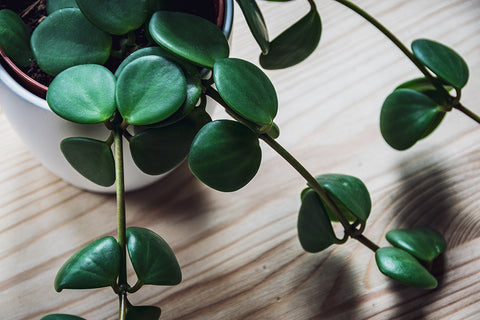
ARE PEPEROMIAS TOXIC TO PETS AND CHILDREN?
The answer is no; Peperomias are not toxic to pets or children. Peperomias are popular houseplants known for their attractive foliage and hardy nature. These plants are safe to keep around pets and children because they do not contain any harmful chemicals. Peperomias are nontoxic and will not irritate the skin if touched. It is important to note, however, that Peperomias have a small amount of saponins, which can cause mild stomach upset if ingested. For this reason, it is best to keep the plants away from small children and pets just to be sure.
A List of Peperomia Varieties
- Peperomia obtusifolia (Baby Rubber Plant)
- Peperomia caperata (Ripple Peperomia)
- Peperomia prostrata (String of Turtles)
- Peperomia argyreia (Watermelon Peperomia)
- Peperomia incana (Felted Peperomia)
- Peperomia puteolata (Parallel Peperomia)
- Peperomia rotundifolia (Trailing Jade)
- Peperomia clusiifolia (Red Edge Peperomia)
- Peperomia ferreyrae (Happy Bean)
- Peperomia tetragona (Parallel Peperomia)
